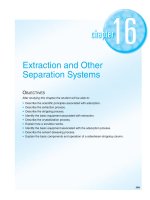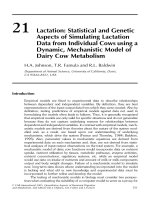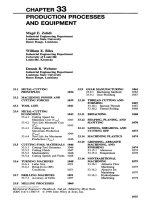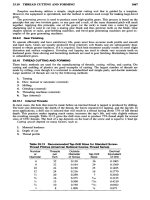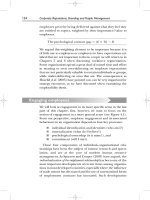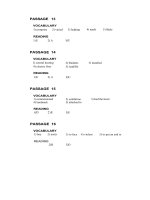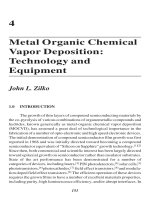slide property, plant and equipment ias 16
Bạn đang xem bản rút gọn của tài liệu. Xem và tải ngay bản đầy đủ của tài liệu tại đây (174.86 KB, 27 trang )
Property, Plant and Equipment:
IAS 16
2
IAS 16 - Overview
Objective and scope
Recognition
Measurement at recognition
Measurement after recognition (CM, RM)
Derecognition
Disclosure
3
IAS 16 - Objective and Scope
Property, plant and equipment are tangible items that:
(a) are held for use in the production or supply of goods or
services, for rental to others, or for administrative purposes;
and
(b) are expected to be used during more than one period”
4
Example 3: An entity (parent) holds a building to earn rentals under
an operating lease from its subsidiary. The subsidiary uses the
building as a retail outlet for its products.
In the parent’s consolidated financial statements the building is
classified as an item of property, plant and equipment. The consolidated
financial statements present the parent and its subsidiary as a single
entity. The consolidated entity uses the building for the supply of goods
over more than one accounting period. In the separate financial
statements of the parent (if prepared) the building is classified as an
investment property and accounted for Investment Property. It is a
property held to earn rentals.
However, if the fair value of the investment property cannot be
measured reliably without undue cost or effort on an ongoing basis, the
parent accounts for the property as property, plant and equipment
5
IAS 16 - Objective and Scope
IAS 16 objective: standards for the recognition and
derecognition of PP&E assets, measurement at and after
acquisition, and disclosures
Scoped out: assets held for sale, agricultural biological assets,
non-renewable natural resource rights and reserves
Includes investment property under construction and when
ready, if cost model applied
6
Example 6: An entity purchases, for one combined
payment, an existing building and the remaining 80-
year interest in a 100-year right to use the land on
which the building sits (freehold ownership of land is
not possible in that jurisdiction). The building is
occupied by the entity’s administrative staff.
The purchase price is split between the land use
right and the building on the basis of the relative fair values
of the two assets. The land use right is accounted for as an
operating lease and the building is accounted for as
property, plant and equipment
7
IAS 16 - Recognition
Costs are recognized as PP&E only if:
1. probable that future economic benefits associated with the
item will flow to the entity, and
2. the cost can be measured reliably.
Applies to costs at acquisition and after
acquisition.
8
IAS 16 - Recognition
The government requires HTY Ltd. to affix new pollution
reduction equipment to existing equipment. Is this a PP&E
cost…or an expense?
Apply general principle:
1. Future economic benefits
2. Reliable measure
9
IAS 16 - Measurement at Recognition
Cost elements to include:
1. Purchase price net of discounts, rebates, and add non-
recoverable taxes, duties
2. Costs to get in place and ready to use as management
intended
3. Costs of obligation to decommission asset and restore site
as a result of acquiring the asset
10
IAS 16 - Measurement at Recognition
Cost elements to exclude:
1. Costs after asset in place and ready for use as management
intended
2. Costs to open a new facility, introduce a product, move to
new location
3. General and administrative overhead type costs
11
IAS 16 - Measurement at Recognition
How to measure cost?
“Cost” is defined (IAS 16.6) as:
Cash or cash equivalents paid or the FV of other
consideration given to acquire asset when acquired or
constructed…
Other IFRS such as IFRS 2: Share-based payment may have
other specific requirements
Exercise 5
An entity acquired a plant for CU2,000,000 on two-years’
interest-free credit.
An appropriate discount rate is 10 per cent per year.
12
Solution
The cost of the plant is CU1,652,893 (ie the present value of
the future payment).
Calculation: CU2,000,000 future payment x 1/(1.1)2.
Note: The unwinding of the discount results in interest expense
recognized in profit or loss respectively of CU165,289 and
CU181,818 in the first and second 12-month period after the
sale. Furthermore, two years after the sale, the liability of
CU2,000,000 (CU1,652,893 + CU165,289 + CU181,818) is
derecognized upon settlement of the debt.
13
14
IAS 16 - Measurement at Recognition
Commercial substance exists if:
1. Cash flows (amount, timing, risk) of new asset differ from
those of old asset(s) transferred; or
2. After-tax cash flows of part of business taking on new asset
(entity specific value) have changed; and
3. Difference in 1 or 2 is significant
15
IAS 16 - Measurement after
Recognition
Choice of two models:
1. Cost model
2. Revaluation model
Separate decision for each class of PP&E
assets. Examples of a class: land, office
equipment, machinery, buildings
16
IAS 16 - Measurement after
Recognition
Cost Model (CM):
PP&E are carried after acquisition at cost, less
accumulated depreciation and accumulated
impairment losses
Revaluation Model (RM):
PP&E are carried after acquisition at fair value at
date of revaluation, less any accumulated depreciation
and impairment losses after revaluation
17
IAS 16 - Measurement after
Recognition: Cost Model (CM)
Depreciation:
Each major component may have a different
depreciation policy
Depreciable amount: carrying amount less residual
value
Residual value defined:
- estimate of net amount entity would receive now
from asset’s disposal, if asset was as old and in same
condition as expected at end of its useful life
18
IAS 16 - Measurement after
Recognition: Cost Model (CM)
Depreciation (continued):
Depreciation period begins when PP&E is in place and ready to
use, continues even if not used or is retired from active use
Depreciation period ends when PP&E is derecognized or
classified as held for sale (IFRS 5)
Depreciate over useful life to entity
19
IAS 16 - Measurement after
Recognition: Cost Model (CM)
Depreciation (continued):
Useful life – consider capacity, wear and tear,
technology changes, changes in product demand,
contractual or legal limits
Choose method based on pattern that asset’s
economic benefits are expected to be received: SL,
DB, or activity-based
If change in pattern, change method prospectively
(change in estimate)
Exercise 6
(a) Asset X was bought for €500,000 five years ago and has
been depreciated at 10% on cost per annum. It is now revalued at
€800,000. There is no change to the useful life.
Question: Show how the above items should be treated in the
financial statements.
20
Solution
(a) Debit Asset X – cost/valuation (€800,000 - €500,000) 300,000
Debit Asset X – accumulated depreciation (€500,000 x 5 x10%)
250,000
Credit Revaluation surplus 550,000 Statement of financial position
(extract)
Property, plant and equipment 800,000
Revaluation surplus 550,000
The revaluation increase should be shown as other
comprehensive income in the entity’s SCI.
Note: you could also increase the carrying value to €800,000 by
debiting €550,000 and crediting revaluation surplus with same.
21
Exercise 9
On 1 January 20X1 an entity acquired an item of heavy machinery for
CU600,000.The machine is made up of three components of equal
value: (i) fixed parts—management estimates fixed parts have a 25-
year useful life with no residual value;(ii) moving parts—management
estimates moving parts have a five-year useful life with no residual
value; and (iii) a foundation—management estimates the foundation
has a 25-year useful life with no residual value.
Furthermore,management judges that the straight-line method reflects
the pattern in which the entity expects to consume the future economic
benefits of all components of themachine.
22
Solution
The entity must allocate the CU600,000 initially recognised to
the three components of the machine. However, fixed parts and
the foundation may be grouped together in determining the
depreciation charge as these components have the same
useful life and both must be depreciated on the straight-line
method. One-third of the cost (or CU200,000) will be allocated
to the moving parts and two-thirds of the cost (or CU400,000)
will be allocated to the combined foundation and fixed parts.
23
Exercise 10
On 1 January 20X1 an entity acquired an item of machinery for
CU500,000.Management estimated the useful life of the machine as
20 years and its residual value as nil. Furthermore, management
believed that the straight-line method reflects the pattern in which it
expects to consume the machine’s future economicbenefits.At the
entity’s 31 December 20X5 financial year-end management’s
assessments of the machine changed. It now estimates the useful life
of the machine as 25 years (measured from the date of acquisition)
and its residual value as CU100,000.Management continues to believe
that the straight-line method reflects the pattern in which it expects to
consume the machine’s future economic benefits.
How must the entity account for the revised assessment of the
machine in the year ended 31 December 20X5?
24
Solution
25
Dr Profit or loss (depreciation expense) CU14,286(a)
Cr Accumulated depreciation CU14,286
To record depreciation expense for the year ended 31 December
20X5.
(a) (CU400,000(b) less CU100,000 residual value) ÷ 21 years’
remaining useful life at the beginning of the current reporting period =
CU14,286
(b) CU500,000 cost less (4 years × CU25,000(c) annual depreciation)
= CU400,000 carrying amount at 1 January 20X5 (31 December
20X4)
(c) Original annual depreciation = CU500,000 ÷ 20 years =CU25,000
